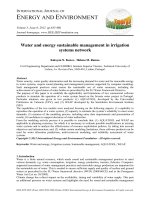Cash and marketable securites management
Bạn đang xem bản rút gọn của tài liệu. Xem và tải ngay bản đầy đủ của tài liệu tại đây (171.81 KB, 30 trang )
Chapter 9
Cash and Marketable
Securities
Management
9-1
Cash and Marketable
Securities Management
◆
◆
◆
◆
◆
9-2
Motives for Holding Cash
Speeding Up Cash Receipts
S-l-o-w-i-n-g D-o-w-n
Cash Payouts
Cash Balances to Maintain
Investment in Marketable
Securities
Motives for Holding Cash
Transactions Motive -- to meet
payments arising in the ordinary
course of business
Speculative Motive -- to take
advantage of temporary opportunities
Precautionary Motive -- to maintain a
cushion or buffer to meet unexpected
cash needs
9-3
Speeding Up
Cash Receipts
Collections
9-4
◆
Expedite preparing and mailing the
invoice
◆
Accelerate the mailing of payments from
customers
◆
Reduce the time during which payments
received by the firm remain uncollected
Collection Float
Float
Processing
Float
Availability
Float
Deposit Float
Collection Float:
Float total time between the mailing
of the check by the customer and the availability
of cash to the receiving firm.
9-5
Mail Float
Customer
mails check
Firm
receives check
Mail Float:
Float time the check is in the mail.
9-6
Processing Float
Firm
receives check
Firm
deposits check
Processing Float:
Float time it takes a company
to process the check internally.
9-7
Availability Float
Firm
deposits check
Firm’s bank
account credited
Availability Float:
Float time consumed in clearing
the check through the banking system.
9-8
Deposit Float
Processing Float
Availability Float
Deposit Float:
Float time during which the check
received by the firm remains uncollected funds.
9-9
Earlier Billing
Accelerate preparation and
mailing of invoices
9-10
◆
computerized billing
◆
invoices included with shipment
◆
invoices are faxed
◆
advance payment requests
◆
preauthorized debits
Preauthorized Payments
Preauthorized debit
The transfer of funds from a payor’s
bank account on a specified date to
the payee’s bank account; the
transfer is initiated by the payee
with the payor’s advance
authorization.
9-11
Lockbox Systems
Traditional Lockbox
A post office box maintained by a firm’s bank
that is used as a receiving point for customer
remittances.
Electronic Lockbox
A collection service provided by a firm’s bank
that receives electronic payments and
accompanying remittance data and
communicates this information to the
company in a specified format.
9-12
Lockbox Process*
◆
Customers are instructed to mail their
remittances to the lockbox location.
◆
Bank picks up remittances several times daily
from the lockbox.
◆
Bank deposits remittances in the customers
account and provides a deposit slip with a list
of payments.
◆
Company receives the list and any additional
mailed items.
9-13
* Based on the traditional lockbox system
Lockbox System
Advantage
Receive remittances sooner which
reduces processing float.
Disadvantage
Cost of creating and maintaining a
lockbox system. Generally, not
advantageous for small remittances.
9-14
Concentration Banking
Cash Concentration
The movement of cash from lockbox or
field banks into the firm’s central cash
pool residing in a concentration bank.
Compensating Balance
Demand deposits maintained by a firm
to compensate a bank for services
provided, credit lines, or loans.
9-15
Concentration Banking
Moving cash balances to
a central location:
9-16
◆
Improves control over inflows and
outflows of corporate cash.
◆
Reduces idle cash balances to a
minimum.
◆
Allows for more effective investments
by pooling excess cash balances.
S-l-o-w-i-n-g D-o-w-n
Cash Payouts
◆
“Playing the Float”
◆
Control of Disbursements
◆
◆
◆
9-17
Payable through Draft (PTD)
Payroll and Dividend
Disbursements
Zero Balance Account (ZBA)
“Playing the Float”
Net Float -- The dollar difference between
the balance shown in a firm’s (or
individual’s) checkbook balance and the
balance on the bank’s books.
You write a check today, which is subtracted
from your calculation of the account balance.
The check has not cleared, which creates float.
You can potentially earn interest on money that
you have “spent.”
9-18
Control of Disbursements
Firms should be able to:
1. shift funds quickly to banks from which
disbursements are made.
2. generate daily detailed information on
balances, receipts, and disbursements.
Solution:
Centralize payables into a single (smaller
number of) account(s). This provides better
control of the disbursement process.
9-19
Methods of Managing
Disbursements
Payable Through Draft (PTD):
A check-like instrument that is drawn against the
payor and not against a bank as is a check. After
a PTD is presented to a bank, the payor gets to
decide whether to honor or refuse payment.
◆ Delays the time to have funds on deposit to
cover the draft.
◆ Some suppliers prefer checks.
◆
9-20
Banks will impose a higher service charge
due to the additional handling involved.
Methods of Managing
Disbursements
Payroll and Dividend Disbursements
The firm attempts to determine when payroll and
dividend checks will be presented for collection.
◆
Many times a separate account is set up to
handle each of these types of disbursements.
◆
A distribution scheduled is projected based on
past experiences. [See slide 9-22]
◆
Funds are deposited based on expected needs.
◆
Minimizes excessive cash balances.
9-21
Percentage of Payroll
Checks Collected
Percent of
Payroll Collected
100%
The firm may plan on
payroll checks being
presented in a similar
pattern every pay period.
75%
50%
25%
0%
F
M
(Payday)
9-22
T
W
H
F
M and after
Methods of Managing
Disbursements
Zero Balance Account (ZBA):
A corporate checking account in which a zero
balance is maintained. The account requires a
master (parent) account from which funds are
drawn to cover negative balances or to which
excess balances are sent.
◆
Eliminates the need to accurately
estimate each disbursement account.
◆
Only need to forecast overall cash needs.
9-23
Cash Balances to Maintain
The optimal level of cash should
be the larger of:
(1) the transaction balances required
when cash management is
efficient.
(2) the compensating balance
requirements of commercial
banks.
9-24
Investment in
Marketable Securities
Marketable Securities are shown
on the balance sheet as:
1. Cash equivalents if maturities are
less than three (3) months at the
time of acquisition.
2. Short-term investments if remaining
maturities are less than one (1)
year.
9-25









